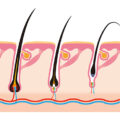Last updated on June 3, 2024
5 Common Hair Loss Myths: The Truth About Male Pattern Baldness
Hair loss is not just annoying. For many men – and women – it can feel like an existential threat to see their hairline receding or to discover a growing bald spot on the back of their head. But here’s the thing: All men (and women) can lose hair. Men of a certain age are especially prone to hair loss, at least from the top of their heads.
It is not until relatively recent times that the causes of hair loss have been better understood and consequently there are many old wives tales and myths that have grown up around the age-old problem of baldness.
Common Male Pattern Baldness Myths
More than half of all men over the age of 50 have some degree of male pattern baldness. But despite the large number of men who are losing their hair, there are a lot of myths and misinformation about how and why hair loss happens.
Here are five misconceptions about baldness that you can put to bed.
- Wearing hats leads to baldness. You don’t need to offload your favorite fedora just yet. There’s zero evidence to suggest that wearing hats — even on a daily basis — leads to hair loss or hair follicle damage. Hats that are dirty, however, can lead to an infection, which can increase the odds that you’ll lose some hair.
- Baldness is your mother’s father’s fault. Moms’ lineage has long been blamed for male pattern baldness, but the reality is, hair loss is a genetic trait you can inherit from either parent. So look at both parents, check out your siblings and even pay attention to first cousins. If baldness is a recurring trait, you may want to pay closer attention to your mane.
- Hair loss means you’re carrying around too much testosterone. The amount of hair on your head has very little to do with the testosterone circulating in your bloodstream. Instead, male pattern hair loss comes down to hair follicle sensitivity to a hormone called dihydrotestosterone (DHT).
- Stress speeds up male pattern baldness. True, traumatic events and emotional overwhelm can trigger temporary hair loss, but this type of hair loss is not the same as male pattern baldness, which is permanent. With trauma-induced hair loss, your hair follicles press pause. After the threat has passed, they resume their “normal” cycle again.
- Hair restoration treatments don’t work. The Food and Drug Administration-approved medication, is one effective method for preventing further hair loss. The drug works by blocking an enzyme that changes testosterone to DHT in the hair follicles. It works best among men whose hair is just beginning to thin. The rub: If you stop taking the medication, your hair loss will continue. The best (and permanent solution) is a transplant of hairs from the back of the head to the front. These hairs are not under the same influence of DHT and can persist over time.
What To Do Before You Go Bald
Hair loss happens — and middle-aged men aren’t the only victims. In fact, hair loss can strike boys during their late teens and it’s not that uncommon among 20- and 30- year-olds. Unfortunately, the earlier male pattern baldness sets in, the more likely it will be severe.
While there’s no cure for a shiny scalp, there are things you can do to stall hair loss. Once hair loss begins, it doesn’t stop. But if maintaining a full head of hair is important to you, it’s important to take action as soon as you notice your hair thinning.
Talk to our team about available treatment options, so you can weigh the risks and benefits of each approach. Whether you choose medication or surgery, you may be able to turn back the clock on your head with a little medical assistance.
[/fusion_text][/fusion_builder_column][/fusion_builder_row][/fusion_builder_container]








